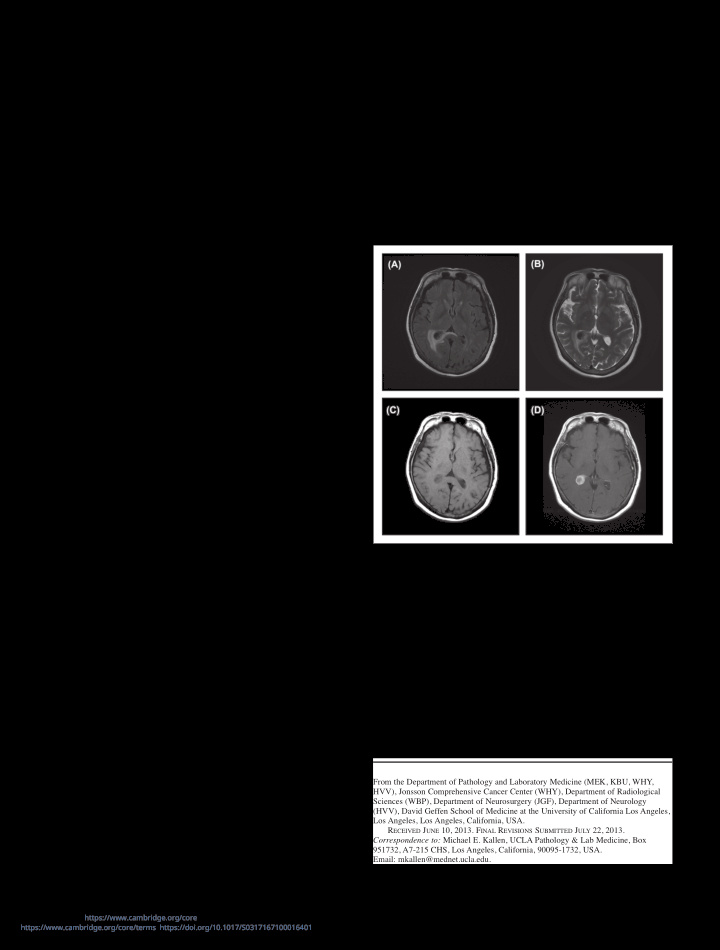



BRIEF COMMUNICATIONS Isolated Choroid Plexus Granulomas: Initial Presentation of Neurosarcoidosis? Michael E. Kallen, Kritsanapol Boon-Unge, William H. Yong, Whitney B. Pope, John G. Frazee, Harry V. Vinters Can J Neurol Sci. 2014; 41: 112-114 Granulomatous mass lesions in the central nervous system (CNS) are most commonly associated with neurosarcoidosis and tuberculosis 1 . The differential diagnosis also includes primary angiitis of the CNS, Wegener’s granulomatosis, idiopathic chronic hypertrophic pachymeningitis, xanthogranulomas, Langerhans cell histiocytosis, and infections resulting from various viral and parasitic agents. These entities do not commonly occur as an isolated single mass within the choroid plexus. Neurosarcoidosis has been rarely reported as an isolated lesion within this site 2 . Additionally, an uncommon entity, pathogen-free granulomatous disease (PFGD) of the CNS describes granulomatous disease confined to the CNS 1 but without systemic evidence of sarcoidosis. We present an unusual case of an isolated granulomatous mass of the right lateral ventricle involving the choroid plexus, in an otherwise healthy patient with minimal significant past medical history. A 63-year-old woman was referred with insidious onset of malaise, headaches, and vision changes. She subsequently developed focal neurological symptoms including twitching of the left hand. Brain magnetic resonance imaging (MRI) (see Figure 1) showed an enhancing lesion involving the right choroid plexus centered in the atrium of the right lateral Figure 1: MRI axial images of the brain showing a T1 and T2 hypo- ventricle, measuring 28 x 15 mm. The MRI noted periventricular intense mass with avid contrast enhancement located within the atrium edema of the white matter with mild dilatation of the right lateral of the right lateral ventricle and involving the choroid plexus. There is ventricle. The patient underwent uncomplicated resection of the vasogenic edema of the peri-atrial white matter best seen on T2-weighted lesion. images. (A) FLAIR (B) T2 (C) T1 without contrast (D) T1 with contrast. Computed tomogram (CT) scan of the chest showed approximately ten pleural and fissure-based micronodules, some with “ground glass” appearance, with no significant hilar One year after the operation, the patient had resolution of her lymphadenopathy. The suggestion of a prominent subcarinal and malaise, headaches, and focal neurologic symptoms. Post- pretracheal node was noted. Transbronchial biopsy of the right operative CT scans showed mild gliosis at the resection margin, upper and lower lung lobes was performed, showing fragments but no regrowth of the mass or new intracranial lesions. She has of normal lung tissue with no significant inflammation or no new signs or symptoms of sarcoidosis, or of any neurologic granulomas, and no evidence of infection or malignancy. disease, but is being treated for presumed neurosarcoidosis with Laboratory findings were notable for negative anti-neutrophil cytoplasmic antibodies (ANCA), positive Mycobacterium tuberculosis (MTB)-quantiferon, Erythrocyte Sedimentation Rate (ESR) 20 mm/hr (reference range 0-22 mm/hr), C-Reactive Protein (CRP) <0.5 mg/dL (reference range < 0.8 mg/dL), From the Department of Pathology and Laboratory Medicine (MEK, KBU, WHY, Angiotensin-Converting Enzyme (ACE) 44 U/L (reference HVV), Jonsson Comprehensive Cancer Center (WHY), Department of Radiological range 10-66 U/L). Sciences (WBP), Department of Neurosurgery (JGF), Department of Neurology The patient had been born in Mexico and moved to the USA (HVV), David Geffen School of Medicine at the University of California Los Angeles, Los Angeles, Los Angeles, California, USA. in the 1960s. She had smoked tobacco in the past but R ECEIVED J UNE 10, 2013. F INAL R EVISIONS S UBMITTED J ULY 22, 2013. discontinued smoking in 2011, and other than a distant history of Correspondence to: Michael E. Kallen, UCLA Pathology & Lab Medicine, Box 951732, A7-215 CHS, Los Angeles, California, 90095-1732, USA. factory work, has no obvious environmental or occupational Email: mkallen@mednet.ucla.edu. exposures. 112 Downloaded from https://www.cambridge.org/core. IP address: 192.151.151.66, on 09 Aug 2020 at 10:30:15, subject to the Cambridge Core terms of use, available at https://www.cambridge.org/core/terms. https://doi.org/10.1017/S0317167100016401
LE JOURNAL CANADIEN DES SCIENCES NEUROLOGIQUES Figure 2: Representative histologic sections showing chronically inflamed connective tissue with numerous granulomas and prominent Schaumann bodies. (A) and (B) show low power views (4x) of the granulomatous inflammation and residual choroid plexus. (C) and (D) show Schaumann bodies, marked with arrows (20x). (E) shows a magnified (20x) view of a granuloma. (F) CD138 highlights plasma cells (20x). (G) Section viewed under polarized light shows refractile material within giant cells (40x). low dose hydroxychloroquine, and for possible latent was no evidence of necrosis. Fragments of residual benign tuberculosis infection with Isoniazid. choroid plexus epithelium were identified within the mass. The specimen consisted of a 3.5 x 1.3 x 1.2 cm well- Remote from the granulomas, dense spherical calcium circumscribed firm soft tissue fragment with a homogeneous cut aggregates were identified, probably representing psamomma surface. Histologic sections showed dense, fibrous, chronically bodies. inflamed connective tissue with numerous granulomas. Many of Immunohistochemical stains were supportive of the granulomas contained prominent Schaumann bodies (see granulomatous inflammation. The CD68 stain highlighted Figure 2C and D), while others showed giant cells with large histiocytes forming granulomas. The CD20 stain highlighted cytoplasmic vacuoles. Some giant cells showed calcified and diffusely scattered and perivascular B-lymphocytes. The CD138 focally refractile cytoplasmic material (see Figure 2G). There stain highlighted scattered plasma cells (see Figure 2F). The Volume 41, No. 1 – January 2014 113 Downloaded from https://www.cambridge.org/core. IP address: 192.151.151.66, on 09 Aug 2020 at 10:30:15, subject to the Cambridge Core terms of use, available at https://www.cambridge.org/core/terms. https://doi.org/10.1017/S0317167100016401
Recommend
More recommend